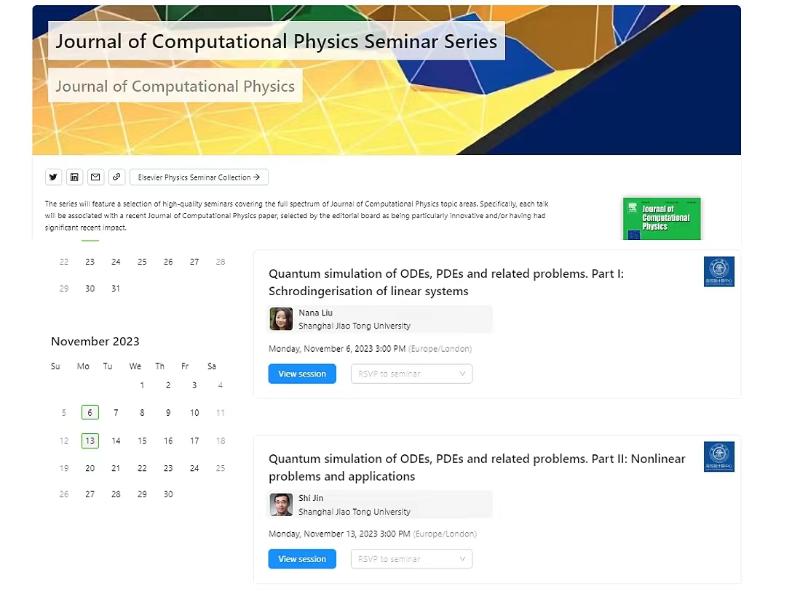
 探索发现 · 交大智慧
探索发现 · 交大智慧
上海交大金石和Nana Liu教授关于偏微分方程量子计算的工作受邀Journal of Computational Physics月度演讲
近日,上海交通大学金石(自然科学研究院和数学科学学院教授)和Nana Liu(自然科学研究院和密西根学院副教授)应邀于2023年11月,在Journal of Computational Physics月度演讲中进行两次联合演讲,介绍他们在偏微分方程量子模拟方面的最新研究工作。

Journal of Computational Physics(JCP)是科学计算和应用数学领域最具影响力的期刊之一,每年发表600多篇文章。2021年秋季启动了JCP月度演讲。入选的论文是由编委遴选过去五年内在该杂志发表的极具创新性或近年来产生过重要影响的(being particularly innovative and/or having had significant recent impact)论文。该讲座系列通常每月一次,而这次是该杂志首次邀请两位演讲者在一个月内就同一个主题连续进行两次讲座。金石教授曾于2021年11月就他与合作者的多体粒子系统和分子动力学的Random Batch 快速计算方法的论文发表了一次演讲。 他是自该系列推出以来唯一在JCP上发表过两次演讲的作者,上海交通大学也是世界上唯一一个有过三次演讲记录的学术机构。
量子计算机根据量子力学原理设计, 适合求解量子力学的基本方程--薛定谔方程, 相应的算法被成为量子模拟。其它在科学和工程中有重要应用的偏微分方程(PDE)则不适合量子模拟。另一方面,由于高维和大规模PDE的经典计算方法有维度灾难,其计算成本随着PDE的维度呈指数级增长,因此人们希望量子计算能克服这些计算瓶颈。而要在量子器件上模拟偏微分方程,寻找将其它偏微分方程映射到薛定谔方程上的好方法至关重要。
在与他们的博士后余越的工作中,他们提出了一种称为“薛定谔化”(Schrodingerization)的方法,通过引进一个简单的变换, 在高一维空间将任何线性偏微分方程转化为薛定谔方程的形式,使得其适用于量子模拟。 这种方法基于连续变量,简单且普适,可以在有限维和无限维量子系统中应用。前者对应用量子比特(qubits),后者对应于量子模(qumodes)。量子比特和量子模都可以通过光量子系统和超导体等物理平台来实现。基于连续变量的计算框架对于偏微分方程来说可能更自然,它与大多数计算方法不同,这里不需要首先离散偏微分方程,可以将D维线性PDE直接映射到(D+1)个量子模的量子系统上,并可以对(D+1)个量子模采用量子模拟。
他们用薛定谔化的方法构造了对Liouville方程,热传导方程,Fokker-Planck方程, Maxwell’s方程和金融领域的Black-Scholes方程的量子模拟方法。该方法还可以处理边界——包括物理和人工边界——以及界面问题, 也可以扩展到具有不确定性的线性偏微分方程,以减轻经典不确定性量化算法中存在的维数灾难。
非线性偏微分方程一直是物理、化学、工程、生物学和金融等领域一些最重要问题建模的核心。然而,用量子模拟来模拟这些问题是困难的,因为量子力学本身基本上是线性的。目前求解非线性偏微分方程的量子算法均基于对这些方程做线性逼近。 这样会失去方程解的许多重要的非线性特征。利用水平集的方法,金石和Nana Liu将Hamilton-Jacobi和标量双曲型偏微分方程等非线性偏微分方程精确映射为维数不超过一倍的线性偏微分方程。经典计算方法会随着维度的增加计算量指数级地增加,但量子算法则避免了这样的维数灾难,从而使构造这些非线性问题的量子算法成为可能。
这些方法如何扩展到更广泛的偏微分方程是未来工作的一个重要方向。
团队的工作得到了国家自然科学基金委员会、上海市科委和上海市教委创新计划的支持。
相关论文:
1.Quantum simulation of partial differential equations: applications and detailed analysis, Shi Jin, Nana Liu, Yue Yu, Physical Review A, Vol 108, 032603, 2023
2.Time complexity analysis of quantum algorithms via linear representations for nonlinear ordinary and partial differential equations, Shi Jin, Nana Liu, Yue Yu, Journal of Computational Physics, Vol 487, 112149, 2023
Journal of Computational Physics (JCP) is one of the most influential journals in scientific computing and applied mathematics, which publishes more than 600 articles each year. The JCP Seminar Series, launched in Fall 2021, is held once a month, based on articles published in JCP in recent years that are considered by the editorial board as “particularly innovative and/or having had significant recent impact”. Prof. Shi Jin and Prof. Nana Liu have been invited to give a joint series of two talks on their recent body of work on quantum simulation for partial differential equations (PDEs). This seminar series usually holds one lecture per month, and this is the first time the journal invites two speakers to give two consecutive lectures in one topic. Prof. Jin gave a lecture in this seminar serious in November 2021 on his work on Random Batch methods for interacting particle systems and molecular dynamics. He is is the only author of JCP who has given two lectures in this seminar series since its launch, and Shanghai Jiao Tong University is the only institute in the world with more than two lectures given.
Quantum simulation — using a quantum system to simulate dynamics of another system — has been chiefly of interest for the simulation of one PDE in particular: Schrodinger’s equations. For other PDEs important in science and engineering, they are not suitable for quantum simulation. On the other hand, classical computational methods for other high-dimensional and large-scale PDEs often suffer from the curse-of-dimensionality, where the cost scales exponentially in the dimension of the PDE, which a quantum treatment might in certain cases may be able to mitigate. To enable the simulation of PDEs on quantum devices in the first place, it is crucial to first develop good methods for mapping other PDEs onto Schrodinger’s equations.
In their work, Prof. Jin and Prof. Liu, jointly with their postdoc Yue Yu, proposed a method called Schrodingerisation, which is a simple and generic method for transforming any linear partial differential equation into a Schrodinger-like form by the inclusion of one extra spatial dimension. This formalism is flexible and simple enough to be adopted on both finite dimensional and infinite-dimensional quantum systems. The former are called qubits and the latter are called qumodes. Both qubits and qumodes can be realized by physical platforms such as quantum photonic systems and superconductors. Computation with these physical systems are the quantum versions of classical bit-based and classical analogue computation respectively. This continuous representation of information in the latter case can be more natural for PDEs since, unlike most computational methods, here one does not need to discretise the PDE first. In this way, one can directly map a D-dimensional linear PDE onto a (D + 1)-qumode quantum system where quantum simulation on (D + 1) qumodes can be used. In terms of spatial requirement, this is much more efficient compared to the number of terms needed by a classical computer to even describe the total number of lattice points in the discretised PDE, where is the number of lattice points per spatial dimension.
Linear PDEs like Liouville equation, heat equation, Fokker-Planck, Maxwell’s equations and Black-Scholes have been investigated. The method can also deal with boundary--both physical and artificial boundary conditions--and interface problems. The quantum approach can also be extended to consider linear PDEs with uncertainties, which can alleviate the curse of dimensionality present in classical algorithms.
Nonlinear PDEs have been central to modelling of some of the most significant problems in physics, chemistry, engineering, biology and finance. However, simulating these with quantum simulation has proved difficult because quantum mechanics itself is fundamentally linear and it is difficult to model nonlinear problems in a linear way without significant approximations that no longer capture truly nonlinear behaviour. By leveraging the concept of level sets, this team mapped nonlinear PDEs like Hamilton-Jacobi and scalar hyperbolic PDEs exactly into linear transport PDEs in at most twice the dimension. While classical methods would suffer from the curse of dimensionality with this increase in dimension, a quantum algorithm would not, thus making quantum algorithms for these nonlinear problems more efficient. Extension to wider classes of PDEs is an important direction of future work.
The work of Prof. Shi Jin and Prof. Nana Liu’s team is sponsored by National Natural Science Foundation of China, the Innovation Program of Shanghai Municipal Education Commission, the Shanghai Science and Technology Program of Shanghai and the Fundamental Research Funds for the Central Universities.
Source:
1.Quantum simulation of partial differential equations: applications and detailed analysis, Shi Jin, Nana Liu, Yue Yu, Physical Review A, Vol 108, 032603, 2023
2.Time complexity analysis of quantum algorithms via linear representations for nonlinear ordinary and partial differential equations, Shi Jin, Nana Liu, Yue Yu, Journal of Computational Physics, Vol 487, 112149, 2023